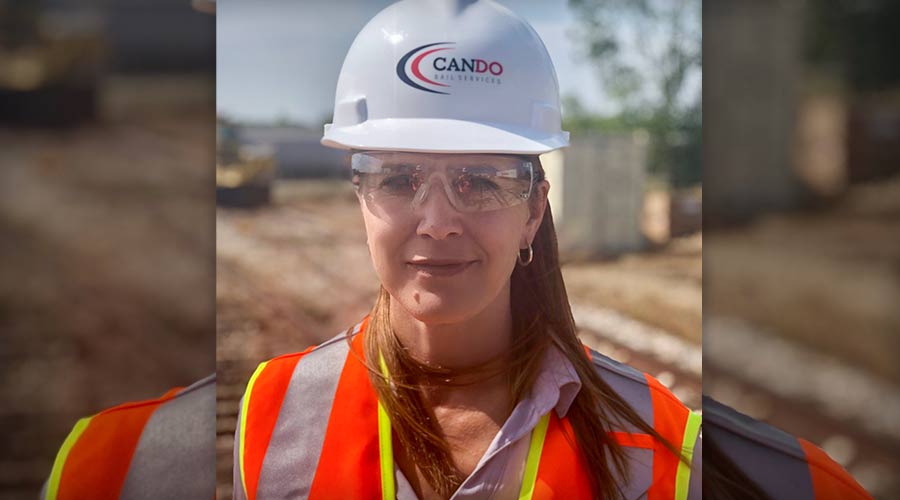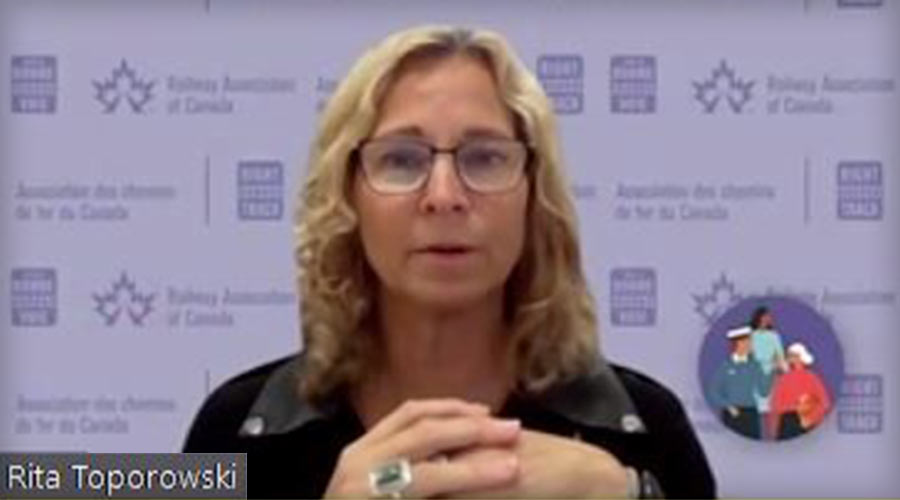Women in rail: Mentors are key to retention, panelists say
6/28/2022
By Julie Sneider, Senior Associate Editor
Mentorship programs are key to helping the rail industry solve its labor shortage, particularly when it comes to attracting and retaining women and other people who are under-represented in the workforce.
That was the message shared by four panelists at the second annual Railway Association of Canada’s Women in Rail Conference, which was held virtually June 8-9.
The panel’s topic centered on the role mentors play in helping women advance in the rail business. Serving on the panel were four female leaders in Canada’s rail and transportation fields: Fiona Murray, a recently retired executive with CN; Rita Toporowski, vice president of customer experience at VIA Rail Canada; Lisa Smith, assistant vice president of safety, environmental and regulatory at Cando Rail and Terminals; and France Pegeot, chair of the Canadian Transportation Agency.
 “Mentoring applies across all people at Cando. That is our mandate.” — Lisa Smith, Cando Rail and Terminals Cando Rail and Terminals
“Mentoring applies across all people at Cando. That is our mandate.” — Lisa Smith, Cando Rail and Terminals Cando Rail and TerminalsThe panel’s moderator was Jennifer Menard-Shand, a Canadian entrepreneur and founder and CEO of Staff Shop Inc. Menard-Shand began the discussion by asking the panelists why they believe the conversation over rail workforce diversity — especially in the recruitment and mentoring of more women — is important.
Murray, who was vice president of government affairs and communications when she retired in 2021 after a 30-year career with CN, said the issue boils down to preserving the industry’s future.
“This conversation isn’t just about women, it is about the sustainability of the rail industry,” said Murray, noting the extremely tight labor market. “Railroads are competing to attract the best employees. If you are an employer and are not making yourself attractive and open to women and people of diverse backgrounds, you are fishing in a much smaller pond. Why limit yourself to half the population?”
Making railroading a more female-friendly business “is about our survival and being a sustainable industry,” she added.
At VIA Rail, executives are trying to recruit enough workers to return service to pre-pandemic levels, said Toporowski. The majority of VIA’s board and senior leadership is female, but there are gaps in middle management, skilled trades and technical positions, she said. VIA and railroads in general have to demonstrate they offer female job applicants a path to career growth.
“You have to show you have the role models and the development plan, and that you understand the needs of this new young workforce,” Toporowski said.
Smith recognized female role models who “bulldozed the path” for women like her and others on the panel to enter rail. Although some progress has been made, more is necessary.
“Now we need to really focus on getting more young women — any women – to join the rail industry because, to be perfectly frank, when I look around the field, I don’t see the demographic there that I know can bring a lot to the table,” Smith said.
Menard-Shand asked the panelists how they’ve benefited from mentorship and how it’s used in their organizations.
At Cando Rail, 70% percent of the leadership team that reports to the CEO is female, said Smith.
“We’ve also had 23 women go through our leadership development program, and we are proud of that,” Smith said. “Mentoring applies across all people at Cando. That is our mandate.”
Mentorship is an “integral core function of most aspects of what I do, hopefully what we all do,” she said, adding she has and continues to benefit from mentorship. She encouraged other leaders to offer mentorship to younger women seeking to advance in rail careers.
Mentorship boils down to something simple: It’s about having a conversation, said VIA Rail’s Toporowski.
“It can be informal. It can be with your own team; it can be outside your team. It's about creating a connection and conversation that allows for people to display vulnerabilities in a way that they don’t feel scared,” she said. “And it works both ways: The more you help people and offer them development opportunities, the more it helps you in your career.”
 “If you are an employer and are not making yourself attractive and open to women and people of diverse backgrounds, you are fishing in a much smaller pond.” — Fiona Murray, CN retiree cn.ca
“If you are an employer and are not making yourself attractive and open to women and people of diverse backgrounds, you are fishing in a much smaller pond.” — Fiona Murray, CN retiree cn.caAlthough VIA Rail doesn’t currently offer a formal mentorship program, it recently began participating in a Montreal program that pairs students interested in transportation careers with leaders who work in the industry. VIA Rail has 11 people serving as mentors to those students.
Murray said that even though she’s now a retired railroader, she continues to coach and mentor people in rail.
“Mentoring is hopefully that two-for-one deal,” she said. “It keeps me plugged in and it gives me satisfaction to help other women,” she said. “Many mentees are really looking for someone to guide them a bit. I think the fancy word is ‘mentorship,’ but really, it’s about caring and putting time into each other.”
Finally, Menard-Shand asked the panelists to share advice they’d offer women interested in rail careers and also to address any misconceptions about the industry that they should be aware of.
“First, get on board,” said Murray. “This is a fascinating industry — whether it’s Class I, short line, passenger or commuter rail. This is an industry that is plugged into every aspect of Canadian life. You’ll learn how Canada works. I tell people: If you are curious and want to know how things work and fit together, it’s a great dynamic and you’ll never have a dull day.”
Murray also emphasized that someone can have multiple careers in rail, which was her own experience. In addition to operating and running the trains, there are support functions — legal, human resources, environmental, sales, marketing and communications — “that make the wheels on the railway continue,” Murray said.
“I had multiple careers. I started in the library, but that was the shoe in the door,” she added. “I worked in procurement, sales and marketing, then public government affairs and corporate communications. I think we have to do a better job of engaging with young people with diverse backgrounds and get them to think about rail when they come out of university.”
Smith, who spent most of her rail career in operations, encouraged younger women interested in rail to “be more courageous than afraid.”
“I started off as a conductor/locomotive engineer and went into management,” she said. “But with every step in my career, there were moments that I was terrified. I vividly remember the first time I kicked off the brake on my very first trip as a qualified engineer. And I remember the first time I made a presentation to a CEO. While I was afraid, I was so determined.”
One perception some people have is that rail is an unfriendly field for women. In her experience, that has not been the case, Smith said.
 “The more you help people and offer them development opportunities, the more it helps you in your career.” — Rita Toporowski, VIA Rail Canada Screenshot, Railway Association of Canada’s Women in Rail Conference
“The more you help people and offer them development opportunities, the more it helps you in your career.” — Rita Toporowski, VIA Rail Canada Screenshot, Railway Association of Canada’s Women in Rail Conference “I don’t know if I ever worked with a peer in this industry who didn’t accept me,” she said. “They may not have liked me, but they accepted and respected me. … There really is a shift in the industry, a recognition from all parties that women are just as capable as men.”
A rail career allows someone to set “their own table,” explained Toporowski.
“It’s a multifaceted industry,” she said. “It’s not just about moving trains, it’s about moving people. Where you start isn’t necessarily where you’ll end up five years down the road.”
The industry’s future challenge will be holding onto workers for a longer period of time, Toporowski noted.
“People move on to different careers,” she said. “The idea that people spend 40 or 50 years in one place is not the case anymore, and we (the rail industry) have to stay relevant.”


